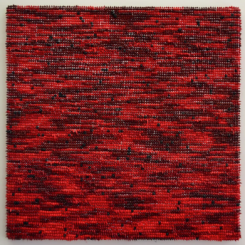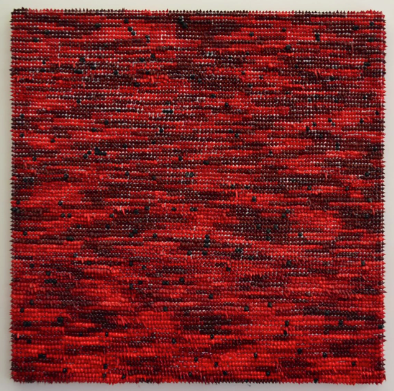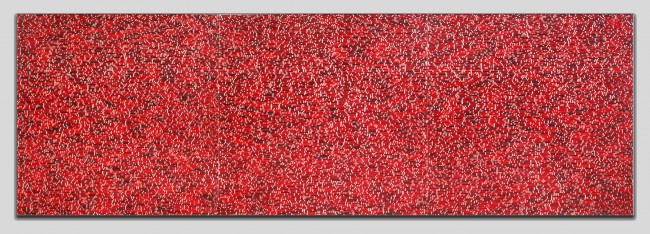In 2011, painter Li Zhenwei confounded all expectations by being awarded Beijing’s Central Academy of Fine Art’s top painting prize. A signature piece by the artist also entered the school’s permanent collection. As a student Li (b. 1987, Liaoning) developed a laborious and highly involved painting practice which diverged significantly from his teachers’ more conventional recommendations — a practice which generally met with incomprehension from his contemporaries. Li’s work can conveniently be described as “abstract.” It also mobilizes something of the discipline explored through Optical Art, which interrogates the mechanics of the human eye and generates vacillating visual effects. Li’s paintings are also transformed — through the use of thick globular paint — into tactile, sculptural image-objects.
Li Zhenwei represents a contemporary development in the compelling relationship in China with abstraction. Purely abstract painting was of course pioneered in the West, but undeniably drew deeply on Chinese practices of non-representational, gestural expressions found in landscape painting and especially calligraphy. Both of these forms contain powerful elements of abstraction, even if their scope extends way beyond a narrow definition of the term. For early Chinese pioneers like Zao Wou Ki, expressive painterly abstraction created a whole new response to Modernity that related directly to their own Chinese aesthetic experience.
In Mainland China after 1949, orthodox Socialist Realism, with its absolute insistence on narrative and single, incontrovertible readings, was universally imposed. Artists in China had to wait until the 1980s before they could again explore abstract expression, which remained highly controversial. In the new climate of the mid 1990s, however, a strange thing was taking place in China. Abstract painting’s non-narrative structure and subjective ambiguity made it appear ideologically neutral, and abstract painting suddenly found itself becoming one of the official faces of the Reform period. This marks a very conscious return to an earlier 20th century vision of modernity that was surely in conscious opposition to the overtly political new painting or subversive body art movements of the time.
Nevertheless, Li Zhenwei’s non-representational image-objects locate his artistic concerns clearly in a territory beyond simple representation-versus-abstraction. This body of work is the result of an intense period of personal research and experimentation. While there is a palpable and hypnotizing repetitive process involved in the actual creation of these works, they are not fundamentally an expressive attempt to embody the artist’s personal experience. Rather, Li is grounded in a position of enquiry and contemplation which begins with cosmology and metaphysics. He meticulously immerses himself in algorhythmic sequencing; this he then reproduces, like a receptor, on the canvas. Look for instance at “Untitled, Premature,” 2012, (无体,觞) in which the artist inverts the traditional cosmology of the circle within the square on which Chinese philosophical thought is grounded. Li’s square patterning of marks is generated through the digitized algorithm of Pi – the formula which describes the circle but which is in itself a never-ending sequence of digits. In contemplating these works we, as viewers, also find ourselves tilting perilously inwards towards perpetual vortexes.
Li suggests a dilemma in which cosmological certainty has been literally turned inside out. By extension, he is also referring directly to the functioning of social and political structures as they face urgent contemporary issues such as globalization, ecology, nationalism and the ever more threatened place of the individual. All are issues which concern the artist deeply.
The paintings of Li Zhenwei are, ultimately, tactile handmade objects. In Li’s new upside-down cosmology, the individual is placed very firmly at the center: the artist in laboring over them like a sorcerer over a knotted carpet, and the spectator in wanting to reach out, touch and even to take an illicit taste.
Irrational Transcendent: Li Zhenwei solo exhibition
Telescope (10, Caochangdi, Beijing) Apr 6 – Jun 2, 2013



